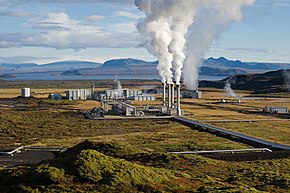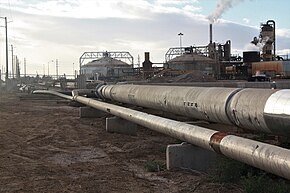

| Part of a series on |
| Renewable energy |
|---|
 |
Geothermal energy is thermal energy extracted from the Earth's crust. It combines energy from the formation of the planet and from radioactive decay. Geothermal energy has been exploited as a source of heat and/or electric power for millennia.
Geothermal heating, using water from hot springs, for example, has been used for bathing since Paleolithic times and for space heating since Roman times. Geothermal power, (generation of electricity from geothermal energy), has been used since the 20th century. Unlike wind and solar energy, geothermal plants produce power at a constant rate, without regard to weather conditions. Geothermal resources are theoretically more than adequate to supply humanity's energy needs. Most extraction occurs in areas near tectonic plate boundaries.
The cost of generating geothermal power decreased by 25% during the 1980s and 1990s.[1] Technological advances continued to reduce costs and thereby expand the amount of viable resources. In 2021, the US Department of Energy estimated that power from a plant "built today" costs about $0.05/kWh.[2]
In 2019, 13,900 megawatts (MW) of geothermal power was available worldwide.[3] An additional 28 gigawatts provided heat for district heating, space heating, spas, industrial processes, desalination, and agricultural applications as of 2010.[4] As of 2019 the industry employed about one hundred thousand people.[5]
The adjective geothermal originates from the Greek roots γῆ (gê), meaning Earth, and θερμός (thermós), meaning hot.
- ^ Cothran, Helen (2002), Energy Alternatives, Greenhaven Press, ISBN 978-0737709049[page needed]
- ^ "Geothermal FAQs". Energy.gov. Retrieved 2021-06-25.
- ^ "Renewables 2020: Global Status Report. Chapter 01; Global Overview". REN21. Retrieved 2021-02-02.
- ^ Fridleifsson, Ingvar B.; Bertani, Ruggero; Huenges, Ernst; Lund, John W.; Ragnarsson, Arni; Rybach, Ladislaus (2008-02-11). O. Hohmeyer and T. Trittin (ed.). "The possible role and contribution of geothermal energy to the mitigation of climate change" (PDF). IPCC Scoping Meeting on Renewable Energy Sources conference, Proceedings. Luebeck, Germany: The Intergovernmental Panel on Climate Change: 59–80. Archived from the original (PDF) on March 8, 2010. Retrieved 2009-04-06.
- ^ "IRENA – Global geothermal workforce reaches 99,400 in 2019". Think GeoEnergy - Geothermal Energy News. 2 October 2020. Retrieved 2020-10-04.